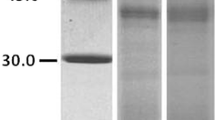Abstract
Cyn d Bd46K, a 46-kD component of Bermuda grass(Cynodon dactylon) pollen, had been identified as an allergenic constituent. In the present study two-dimensional (2D) gel electrophoresis illustrated the presence of five acidic isoforms in Cyn d Bd46K, and this molecule was purified by monoclonal antibody (MAb) affinity chromatography for further characterization. Using a digoxigenin-labeled lectin-binding assay, the elucidating protein was disclosed to be a glycoprotein with terminal mannose. The involvement of a carbohydrate moiety in the allergenicity and antigenicity of the elucidated molecule was demonstrated with sodium-periodate-treated Cyn d Bd46K, which reduced binding to its specific MAb and human IgE. We were unable to identify the N-terminal amino acid sequences of Cyn d Bd46K, but some internal amino acid sequences were disclosed by microsequencing some fragments cleaved byAchromobacter protease I and fractionated by reversed-phase column chromatography. The amino acid sequences of 4 identified Cyn d Bd46K internal peptide fragments were found to be 25–71% identical with that of cytochrome c oxidase III from corn grass pollen. The present study provided important information for future experiments on the molecular cloning of the elucidated allergen.
Similar content being viewed by others
References
Chang HN, Lin FM, Chang YF. Correlation of skin test to RAST, and PRIST in asthmatic patients. Chin Med J 34:376–383;1984.
Chang ZN, Tsai LC, Chi CW, Wang MC, Shen HD, Lee DT, Han SH. Analysis of allergenic components of Bermuda grass pollen by monoclonal antibodies. Allergy 46:520–581;1991.
Chang ZN, Chi CW, Sun HF, Tsai LC, Lee DT, Han SH. A unique human IgE-binding epitope on the Bermuda grass pollen recognized by mouse lambda-type monoclonal antibodies. Clin Exp Allergy 21:503–509;1991.
Chang ZN, Liu CC, Peng HC, Tsai LC, Han SH. A common allergenic epitope of Bermuda grass pollen shared by other grass pollens. J Biomed Sci 1:93–99;1994.
Chang ZN, Liu CC, Tam MF, Peng HJ, Tsai JJ, Han SH. Characterization of the isoforms of the group I allergen ofCynodon dactylon. J Allergy Clin Immunol 95:1206–1214;1995.
Chang ZN, Peng HJ, Lee WC, Chen TS, Chua KY, Tsai LC, Chi CW, Han SH. Sequence polymorphism of the group I allergen of Bermuda grass pollen. Clin Exp Allergy 29:488–496;1999.
Haavik S, Smestad Paulsen B, Wold JK. Glycoprotein allergens in pollen of timothy. V. Significance of the carbohydrate moiety for the immunological activity of a basic glycoprotein allergen. Int Arch Allergy Appl Immunol 87:231–237;1987.
Han SH, Chang ZN, Chi CW, Peng HC, Liu CC, Tsai JJ, Tam M. Use of monoclonal antibodies to isolate and characterize Cyn d 1, the allergen of Bermuda grass pollen. J Allergy Clin Immunol 92:549–558;1993.
Hjelmeland LM, Nebert DW, Chrambach A. Electrofocusing of integral membrane proteins in mixtures of zwitterionic and nonionic detergents. Anal Biochem 95:201–208;1979.
Jaggi KS, Ekramoddoullah AKM, Kisil FT, Dzuba-Fischer JMM, Rector ES, Sehon AH. Identification of two distinct allergenic sites on ryegrass-pollen allergen, Lol p IV. J Allergy Clin Immunol 83:845–852;1989.
Koshte VI, Kagen SL, Aalberse RC. Cross-reactivity of IgE antibodies to caddis fly with arthropoda and mollusca. J Allergy Clin Immunol 84;174–183;1989.
Lin RY, Shen HD, Han SH. Identification and characterization of a 30 kD major allergen fromParapenaeus fissurus. J Allergy Clin Immunol 92:837–845;1993.
McCarty DM, Hehman GL, Hauswirth WW. Nucleotide sequence of theZea mays mitochondrial cytochrome oxidase subunit III gene. Nucleic Acids Res 16:9873;1988.
Meyers RL, Berns-Mason AW, Trayer KH, Feldman BH, Rosengren HN. Isolation and characterization of the dialysate from Bermuda grass pollen. J Allergy 47:100–101;1971.
Mohapatra SS, Nicodemus CF, Schou C, Valenta R. Recombinant allergens and epitopes. Allergy Clin Immunol News 2:45–48;1994.
Shen HD, Wang SR, Tang RB, Chang ZN, Su SN, Han SH. Identification of allergens and antigens of Bermuda grass(Cynodon dactylon) pollen by immunoblot analysis. Clin Allergy 18:401–409;1988.
Shibuya N, Goldstein IJ, Broekaert WF, Nsimba-Lubaki M, Peeters B, Peumans WJ. The elderberry (Sambucus nigra L.) bark lectin recognizes the Neu5Ac(α2–6)Gal/GalNac sequence. J Biol Chem 262:1596–1601;1987.
Shibuya N, Goldstein IJ, Van Damme EJM, Peumans WJ. Binding properties of a mannose-specific lectin from the snowdrop(Galanthus nivalis) bulb. J Biol Chem 263:728–734;1988.
Smith PM, Suphioglu C, Griffith J, Theriault K, Knox B, Singh MB. Cloning and expression in yeastPichia pastoris of a biologically active form of Cyn d 1, the major allergen of Bermuda grass pollen. J Allergy Clin Immunol 98:331–343;1996.
Smith PM, Xu H, Swoboda I, Singh MB. Identification of a Ca2+ binding protein as a new Bermuda grass pollen allergen Cyn d 7: IgE cross-reactivity with oilseed rape pollen allergen Bra r 1. Int Arch Allergy Immunol 114:265–271;1997.
Su SN, Shu P, Lau GX, Yang SY, Huang SW, Lee YC. Immunologic and physicochemical studies of Bermuda grass pollen antigen BG60. J Allergy Clin Immunol 98:486–494;1996.
Tretter V, Altmann F, Kubelka V, Marz L, Becker WM. Fucose α1–3 linked to the core region of glycoprotein N-glycans creates an important epitope for IgE from honeybee venom allergic individuals. Int Arch Allergy Immunol 102:259–266;1993.
Trinca JC. Pollens used in the treatment of hay fever and asthma in eastern Australia. Med J Aust 49:969–972;1962.
Wang WC, Cummings RD. The immobilized leukoagglutinin from the seeds ofMaachia amurensis binds with high affinity to complex-type Asn-linked oligosaccharides containing terminal sialic acid-linked α-2,3 to penultimate galactose residues. J Biol Chem 263:4576–4585;1988.
Woodward MP, Young WW, Bloodgood RA. Detection of monoclonal antibodies specific for carbohydrate epitopes using periodate oxidation. J Immunol Methods 78:143–153;1985.
Author information
Authors and Affiliations
Rights and permissions
About this article
Cite this article
Wu, WC., Tam, M.F., Peng, HJ. et al. Isolation and partial characterization of a 46-kD allergen of Bermuda grass pollen. J Biomed Sci 8, 342–348 (2001). https://doi.org/10.1007/BF02258376
Received:
Accepted:
Issue Date:
DOI: https://doi.org/10.1007/BF02258376




